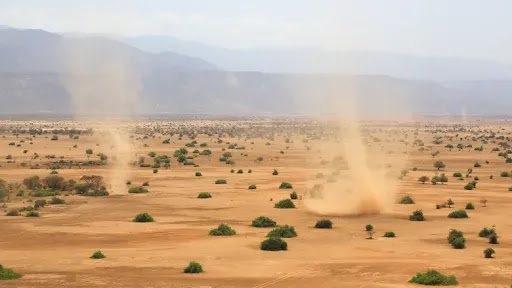WHAT EXACTLY ARE DUST DEVILS?
BY RICHARD MILNER/JAN. 1, 2023
Dust devils are one of those lesser-known meteorological phenomena that not only happen rarely, but are poorly understood. After all, when folks think of "weather," they might think of big, turbulent, headline-catching systems like hurricanes and blizzards. Dust devils, though, are tiny and can vanish within a few minutes, as the National Weather Service says. Known by a variety of names — dusters, whirlwinds, cyclones, or even willy willies — "sandspout" might be the best physical description. Dust devils typically look like funnels of sand spiraling up from the ground. Unlike their much bigger, ultra-destructive cousin tornadoes, however, dust devils are really nothing to worry about except under the most extreme conditions. And even then, they're not too dangerous.
By the most basic definition, a dust devil is a vortex: a mass of fluid, gas, or debris that looks like it's spinning around an invisible pole, per Definitions.net. This means that dust devils fall in the same general category of weather as hurricanes and tornadoes. All three feature spinning air, and are formed by the same collision of different air types: hot versus cold, moist versus dry, etc. But whereas hurricanes form over water when cold air slides under warm air (per the National Ocean Service), and tornadoes spiral down from clouds when hot air rises through cold air (per National Geographic), dust devils form on the ground. If ground temperature rises quickly, hot air can rush up through cold, heavier air and spiral into a dusty funnel shape.
SPIRALING INTO A VACUUM
To understand how dust devils work, it might help to think back to elementary school lessons about heat and air: hot air is light and rises, and cold air is heavy and sinks. This is why if folks get stuck in a burning building, they should get low to the ground. Low air is cooler and breathable, as The New York Times recounts. So what happens if the natural, typical placement of air gets swapped, with cold on the top and hot on the bottom? Hot and cold air rush to replace each other, creating a vacuum that's filled by other air. And if moving air conforms to a spiral-like motion because of gravity and rotational speed, it makes a vortex. Ding ding: dust devil time.
As the National Weather Service continues, dust devils usually happen in certain regions because of those very specific, above-mentioned conditions. Dry, dusty places like Arizona are prime candidates, especially between 11 a.m. and 2 p.m. when the sun rapidly heats the ground. There's got to be a light wind and a clear sky, too, which makes May through June likely months to spot a dust devil. They can happen any time of year, though, so long as the surface is composed of some material that heats much more quickly than the air above it. This is why they often appear above sand. Other likely spots include the junction between types of surfaces, like fields and dirt, or forests and roads.
SWIRLING INTO SHAPE ON EARTH AND MARS
Even though we call them "dust" devils, the phenomenon can be made of any loose, sandy debris small and light enough to be lifted by fast-moving air, as All the Science explains. There's no fear of a dust devil careening into a neighborhood and shredding houses and tossing cars, though. That being said, the National Weather Service reports that a particularly severe dust devil — a rarity, to be sure — hit Arizona's Coconino County Fairgrounds in 2000 at 75 miles per hour. That's as fast as an F1-ranked tornado on the Fujita Scale, as the National Weather Service again reports. However, because of the relatively small size of dust devils, and their short life, they're never going to be a severe threat to human life and property. They climb to heights ranging from 10 to 1000 feet, and are usually harmless enough to walk through, like this dude in South Korea did on Yahoo News.
And in case you think that dust devils exist only on Earth, NASA has recorded footage of them on our celestial neighbor, Mars. As the National Air and Space Museum shows, martian dust devils tend to be way, way bigger than ones on Earth: up to 5 miles tall. One of them, in fact, swept directly through NASA's Perseverance Rover on September 27, 2021, as NASA reports. It was about as non-dramatic as you'd expect, but marked a moment of extreme luck that's hard to capture.


No comments:
Post a Comment